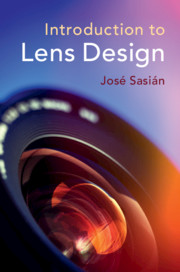Book contents
- Introduction to Lens Design
- Introduction to Lens Design
- Copyright page
- Dedication
- Epigraph
- Contents
- Preface
- 1 Introduction
- 2 Classical Imaging, First-Order Imaging, and Imaging Aberrations
- 3 Aspheric Surfaces
- 4 Thin Lenses
- 5 Ray Tracing
- 6 Radiometry in a Lens System
- 7 Achromatic and Athermal Lenses
- 8 Combinations of Achromatic Doublets
- 9 Image Evaluation
- 10 Lens Tolerancing
- 11 Using Lens Design Software
- 12 Petzval Portrait Objective, Cooke Triplet, and Double Gauss Lens
- 13 Lens System Combinations
- 14 Ghost Image Analysis
- 15 Designing with Off-the-Shelf Lenses
- 16 Mirror Systems
- 17 Miniature Lenses
- 18 Zoom Lenses
- Book part
- Glossary
- Further Reading on Lens Design
- Index
- References
4 - Thin Lenses
Published online by Cambridge University Press: 23 September 2019
- Introduction to Lens Design
- Introduction to Lens Design
- Copyright page
- Dedication
- Epigraph
- Contents
- Preface
- 1 Introduction
- 2 Classical Imaging, First-Order Imaging, and Imaging Aberrations
- 3 Aspheric Surfaces
- 4 Thin Lenses
- 5 Ray Tracing
- 6 Radiometry in a Lens System
- 7 Achromatic and Athermal Lenses
- 8 Combinations of Achromatic Doublets
- 9 Image Evaluation
- 10 Lens Tolerancing
- 11 Using Lens Design Software
- 12 Petzval Portrait Objective, Cooke Triplet, and Double Gauss Lens
- 13 Lens System Combinations
- 14 Ghost Image Analysis
- 15 Designing with Off-the-Shelf Lenses
- 16 Mirror Systems
- 17 Miniature Lenses
- 18 Zoom Lenses
- Book part
- Glossary
- Further Reading on Lens Design
- Index
- References
Summary
This chapter provides a discussion about thin lenses and how they are treated and analyzed for optical imaging. The concept of a thin lens is useful because aberration calculation with formulas is simplified. Structural aberration coefficients are used to determine aberrations and to show the rationale on the choice of the lens shape and aperture stop location. An understanding of how a singlet lens works is indispensable for the design of complex lens systems. The Wollaston periscopic lens, or landscape lens, is discussed regarding the technique of artificially flattening the field of view. A simple optical relay system is discussed, and then complexity is added to correct the primary monochromatic aberrations.
- Type
- Chapter
- Information
- Introduction to Lens Design , pp. 30 - 43Publisher: Cambridge University PressPrint publication year: 2019



